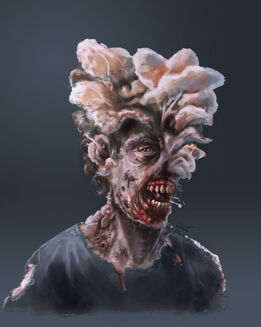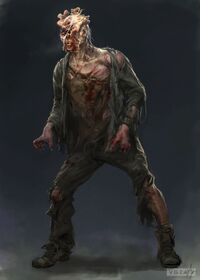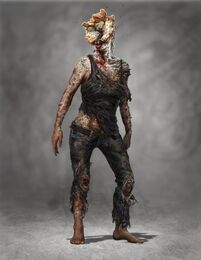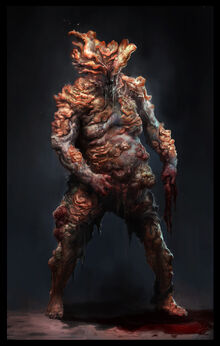
The Infected from the video game The Last Of Us are human beings that have been horribly mutated by a parasitic fungus known as Cordyceps Brain Infection. This fungus propagates within the cranium of its victims and destroys their higher brain functions, turning the infectees into savage animals that are extremely aggressive.
History
According to the storyline of The Last Of Us, the CBI plague spread rapidly across the United States of America in September 2013. Attempts to prevent the infection from spreading beyond US borders failed and it soon reached pandemic proportions, threatening to wipe out mankind.
With society on the verge of collapse, the remnants of the world's governments took drastic steps to protect their remaining populations. In the US, Quarantine Zones were established where uninfected could reside, though living conditions would be consistently poor due to the shortages of supplies and the perpetual state of martial law. Outside the QZ's, the Infected roamed freely and would continuously taint the environment with deadly spores as the fungus kept growing within their bodies.
Biology
Infection
For humans that have been exposed to a mutated strain of Ophiocordyceps Unilateralis, the fungus attacks the brain and begins to alter the behaviour of its host. The host will then go through four different stages of infection: Runner, Stalker, Clicker, and Bloater; each stage is more dangerous than the last.
The infection is also spread directly through contact with an Infected or via their corpse - that is, the infectious spores created by the Cordyceps and released from the host's body upon death. Spore development is the last stage in the life cycle of the Infected. This lifeless carcass serves as a breeding ground for the fungus to spread throughout the environment. When an Infected feels it is close to death, it will find dark, moist corners to die in. While this may be the end of the line for the host, the fungus will live on. The Last of Us game team has stated that the people in the quarantine zones are relatively safe because in places with significant airflow, the spore concentration cannot build up, which is why the only places with significant spore toxicity tend to be underground or abandoned buildings.
In order for the fungus to infect a host body, the host must first be alive. Dead victims who come into contact with the infection do not undergo transformation. All of the infected are weak to fire.
Appearance
As said in the previous section, the Infected humans have since undergone a strange mutation by a specialized strain of cordyceps. Over time, growths protrude out of the orifices of the human hosts and it changes their physical appearance. Their teeth are horribly rotten and jagged. The fungus on Stalkers, Clickers, and Bloaters is bio-luminescent. At later stages, their body begins to bulge, and more fungi growths can be seen on their skin. When the host is killed or dies from advanced fungal growth the fungus continues to grow throughout the body; emitting spores.
Behaviour
Upon becoming Infected, the victims eventually lose any ability to think and begin to behave irrationally as the fungus spreads in the brain. Relying on warped instincts, the Infected will attempt to attack and/or eat any human they find.
As the fungus grows, it spreads to the host's eyes, covering them and blinding them. They then develop a primitive form of echolocation to locate prey, which results in them making a distinctive clicking sound. After some time, the fungus will kill the host if too damaged, usually in a closed-off space so the fungus can spread further.
The Infected, while having a higher pain tolerance than ordinary humans, are still susceptible to conventional injuries. A Runner, when not attacking survivors, will moan in pain due to the fungal growth deforming its body. Clickers will occasionally struggle while being shivved. Sometimes Infected that still have their entire faces intact look sad or worried as they attack. This may indicate that first and second stage infected are aware of what they are doing, but cannot control themselves. Gunshots are capable of startling an infected individual, so it is likely they feel fear in the early stages of infection. However, since their humanity is completely destroyed by stage three, most humanistic characteristics cease entirely (e.g. feelings, thoughts, etc.).
Stages of Infection
Stage 1: Runner

In the earliest stage of infection, the Infected only undergo minor physical changes: their eyes turn red as they bleed and small lesions and warts will grow around the head and neck areas. These Infected are known as Runners as they will typically run after prey at an athletic pace when agitated. While their powers of reason are impaired, Runners often appear to be quite passive and sometimes will not attack even if there is prey right in front of them. This is an indication that the Infected still possess a degree of self-awareness and are resisting the influence of the fungus corrupting their brains. However, if startled by sudden movements or loud noises, the Runners will react and go into an aggressive frenzy. Though they have a higher tolerance for pain than non-infected humans, Runners can still be killed just as easily as non-infected humans.
Stage 2: Stalker

An Infected individual will enter the second stage of infection any time between a week or a year of initial infection. By this point, the infectee has lost all traces of human conscience and will attack others without hesitation. Stage 2 infectees behave in a more stealthy fashion, taking cover in dark corners if spotted from a distance. They will lie in the shadows and duck behind obstructions waiting for the right moment to strike at prey, hence they have been nicknamed "Stalkers". Stalkers can be told apart from Runners by the development of fungal growths from their heads. The fungus will often obscure one of the infectee's eyes, limiting their vision, but at the same time heightening their sense of sound.
Stage 3: Clicker

Clickers are easily recognisable as their heads have been engulfed by fungal growths, leaving only the lower jaw visible. Clickers are completely blind at this point and rely on a primitive form of echolocation to detect prey, producing distinct clicking noises which earn them their name. They are considerably stronger than humans and barely react at all when attacked. They can use their strength to immediately overpower human prey and kill them with a bite to the jugular. Clickers even have a greater resistance to firearms; the fungus covering their faces serves as a natural armour protecting their brains, so bullets will only serve in breaking off pieces of mold.
Stage 4: Bloater

The final stage of the infection is the Bloater, a figure whose body has been bulked up after having fungal plates grow all over the body. The growths serve as natural armour and allow the Bloater to withstand several hits from weapons such as rifles and shotguns and even melee weapons will have little effect. With their bodies weighed down by the fungus encasing them, Bloaters are much slower than other Infected. The fungus covering their bodies produces mycotoxins that the Bloaters can use as a weapon, hurling chunks of mold at prey and poisoning them. They also possess inhuman strength and will instantly kill prey if they grab them by ripping open their heads. Bloaters, as well as all Infected, are particularly weak against fire, so Molotov cocktails are extremely helpful in dispatching groups of Infected.
Death
When the Infected are near death, they will seek out damp and dark areas to settle in. Even after an infected individual has died, the fungus will continue to grow. It grows in to big fungal plants around the body so much as only a few inches but can cover large areas. By this point, the corpse becomes skeletal and brittle, and the fungus sticks the body to whatever surface it is on. The fungus will begin to emit spores from the body which will infect anyone that breathes them in. To combat this, most survivors carry gas masks.
